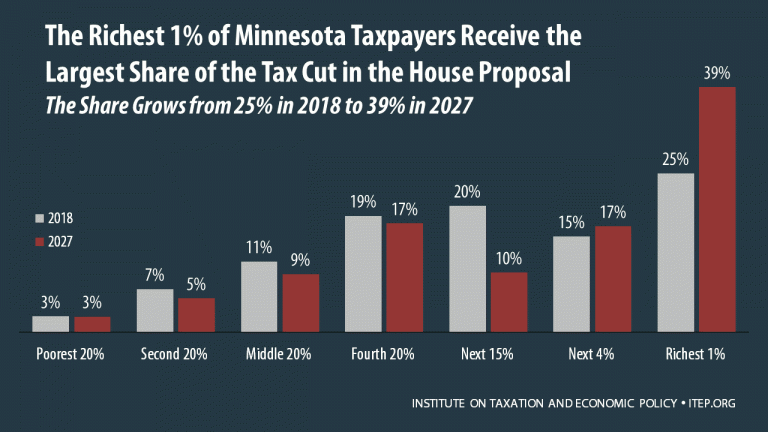The tax bill moving quickly through the U.S. House fails to do what its proponents claim: it is not focused on the middle class. The tax plan provides the largest tax cuts to those already doing well in today’s economy, and their share of the tax cuts grows significantly over time. The bill provides smaller and shrinking tax benefits for lower- and middle-income families, and a significant number of households would see tax increases.
Those are the findings as national experts, including the Tax Policy Center, the Center on Budget and Policy Priorities, and the Institute on Taxation and Economic Policy, have had a chance to dig into the details and see the implications of the bill.
ITEP finds that the 1 percent highest-income American households would get about one-third of the tax cuts in 2018, and nearly half of the tax cuts by 2027. That’s well out of proportion with either their share of total income (22 percent) or the share of total federal taxes this income group pays (26 percent).
For Minnesotans, ITEP finds a similar pattern. The 1 percent of households with incomes above $624,000 would receive 25 percent of the tax cuts going to Minnesotans in 2018, and 39 percent of the tax cuts in 2027. In contrast, the 60 percent of Minnesota households making around $75,000 or less would get just 21 percent of the tax cuts in 2018 and only 17 percent in 2027.

It’s not surprising that the largest share of tax cuts goes to those with the highest incomes, given that’s who benefits most from many of the centerpiece provisions of the House bill: corporate tax rate reductions, cut and repeal of the estate tax, repeal of the Alternative Minimum Tax, and providing special tax treatment for some “pass-through” income.
The share of the tax cuts going to the highest-income households grows in part because a number of provisions focused on middle-class families expire or get smaller as the years pass. A $300 per adult tax credit is temporary and disappears after 2023. The value of the Child Tax Credit, the increased standard deduction, and other elements of the tax code are eroded over time because the bill would adjust these provisions with a slower-growing measure of inflation than is used today.
It’s also the case that for some families, any benefits from provisions like the increased standard deduction and expanded Child Tax Credit are partially or completely outweighed by the loss of personal exemptions, increasing the tax rate in the lowest tax bracket, or other tax changes in the bill. An estimated 135,000 Minnesota children in working-class families are fully left out of the Child Tax Credit expansion — often cited as one of the bill’s primary benefits for families. Add in the 180,000 children who get only a partial benefit, and that’s more than 1 in 4 Minnesota children in working families fully or partially left out.
Some households in every income group would actually face a tax increase; the Tax Policy Center estimates that 7 percent of households would see tax increases in 2018 and 25 percent would see higher taxes in 2027.
Minnesotans are particularly harmed by the proposal to severely limit the State and Local Tax Deduction, which is claimed by more than one-third of Minnesota tax filers. This proposal penalizes states like Minnesota that have relatively higher incomes, that have responded to their residents’ desires for investments in public services, and that fund those services in ways that are more based on income, rather than property or sales taxes.
This bill is based on a theory of trickle-down economics that has failed time and time again to deliver, as the experiences of Kansas and the Bush tax cuts of the 2000s illustrate.
Federal policymakers shouldn’t make the same mistake. Not only will the promised jobs and wage increases fail to materialize, but we’ll all pay the price in terms of the cuts in health care and other essential services that policymakers plan to enact to pay for these tax cuts.
By Nan Madden